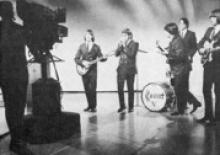While the majority of Grateful Dead fans listen almost exclusively to live recordings, the ensemble’s earliest long player included a gentleman on vocals and harmonica simply known as Pigpen. His presence in the group, prior to his death in 1973, can be considered negligible considering the scope that the ensemble would eventually take on. The spate of blues covers and distorted rock tracks that the Pigpen and the Grateful Dead turned in on the 1967 eponymous disc, though, should rightly be perceived as an important moment in defining garage rock and where it came from.
The Warner Brothers released disc, which contained a few recognizable references to earlier blues-men also sported a track entitled “Cream Puff War,” which should be used to stultify silly hippies who are under the impression that he or she has a complete grasp on their favorite band’s litany of songs. Rarely included in the band’s performances after the ‘60s, the song remains a unique effort from an ensemble that would eventually be renowned for its extended improvisations. The succinct run time of just over three minutes found the Grateful Dead working out a pop construction with distortion doused all over “Cream Puff War’s” chords and solos. Lyrically, the track disguises its political agenda with a scant narrative focusing on an interpersonal relationship.
And while the Grateful Dead’s first album didn’t work to cement its legacy and eschewed much of the time period’s overt drug references. But there were other bands that didn’t demure lyrically or aurally from shocking audiences.
A part of that mid-decade clan of geared up rock and blues enthusiasts were San Jose’s Count Five. Released in 1966, its “Psychotic Reaction” is perceived to be one of the earliest and most blatant references to LSD in rock music. Obviously alluding to drug use, the title doesn’t portend the entirety of the track, which is actually couched in the discussion of an interpersonal relationship.
Parading through Bay Area rock clubs and performing on television, “Psychotic Reaction” took the Count Five on a brief excursion through stardom. The song, which begins with the strangled tones of John Michalski’s electric guitar and Kenn Ellner’s harmonica moves through a staid song structure. As the track reaches its chorus, there’s a drum roll that moves “Psychotic Reaction” into a fast paced section that foreshadows the following decade’s punk predilection. The Count Five’s hit, though, was brief moment in recorded history: a scant three minutes and change.
As important as the song would become in the ensuing years, the fact that the band donned capes while performing live can be seen as the through-line from the ‘60s garage scene to today.
